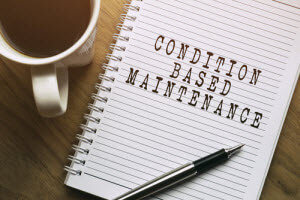How to Use Condition-Based Maintenance to Reduce Costs
Following a manufacturer-recommended maintenance schedule is a rule of thumb for businesses in all industries. However, maintenance schedules aren’t as beneficial as you think. Since most schedules are based on educated guesses and analyses, they’re not always accurate. Because of this, you could end up wasting time and money on unnecessary repairs and replacements.
So how can you provide the services your systems need without wasting time or money? Enter condition-based maintenance.
What’s Condition-Based Maintenance?
 Condition-based maintenance (CBM) uses data collected from a system to calculate exactly when it needs maintenance. It essentially helps companies provide services on an as-needed basis based on the condition of the system rather than a specific time frame. Companies use CBM to reduce overall repair expenses, prevent unnecessary downtime, and extend the longevity of parts and systems in their plants.
Condition-based maintenance (CBM) uses data collected from a system to calculate exactly when it needs maintenance. It essentially helps companies provide services on an as-needed basis based on the condition of the system rather than a specific time frame. Companies use CBM to reduce overall repair expenses, prevent unnecessary downtime, and extend the longevity of parts and systems in their plants.
Types of Condition-Based Maintenance Technologies
With CBM, companies implement different types of technologies to collect data that’s ultimately used to determine when a system will need to be serviced. A few CBM technologies you can add to your plant include the following:
- Vibration Analysis: Sensors that detect increasing and excessive vibrations in compressors, pumps, and other rotating equipment.
- Ultrasonic: Technologies that can spot issues such as boat hull corrosion and deep subsurface defects. They can also be used to find liquid, gas, and vacuum leaks.
- Operational Performance: Sensors placed in different parts of the system to monitor performance aspects like pressure, temperature, and flowrate.
- Infrared: Infrared cameras that can sense elevated temperatures in energized parts and systems.
- Oil Analysis: Technologies that analyze the particle size and condition of oil flowing through a system.
The information gathered from each of these CBM technologies can help you determine when services and repairs are required for each system in your plant. This will allow you to provide the maintenance only when needed to reduce costs.
But installing these technologies and simply monitoring the condition of your machinery won’t be enough. According to Valve World Magazine, testing parts for performance and functionality is also key to keeping your systems running as smoothly as possible for years to come.
Benefits of Condition-Based Maintenance
As stated, CBM helps to reduce overall repair and servicing costs for many industrial companies. However, there are many more benefits to CBM than just decreased expenses.
For example, technologies can collect data while a system is running. This helps to minimize disruptions during normal operations, resulting in enhanced efficiency and productivity in the workplace. CBM also can help to minimize unscheduled downtime and reduce the time spent on repairs and maintenance.
Most importantly, CBM can improve workplace safety. It will make sure that systems are properly maintained, which helps to prevent catastrophic failures and damages that can cause injuries for workers on the production floor.
For more information about how you can reduce operation costs for your manufacturing business, read our post on how to design a cost-effective warehouse.

